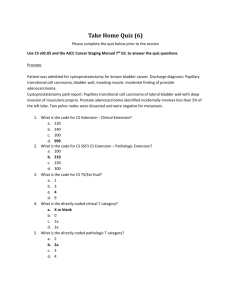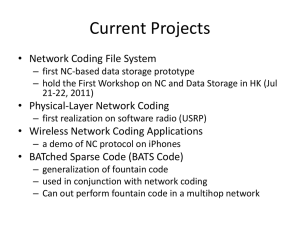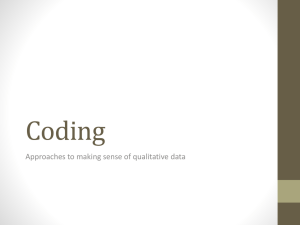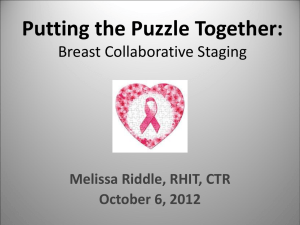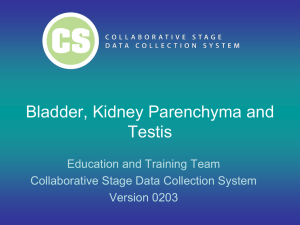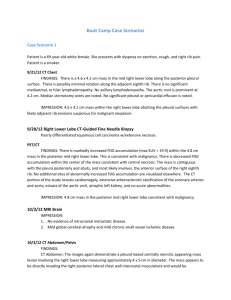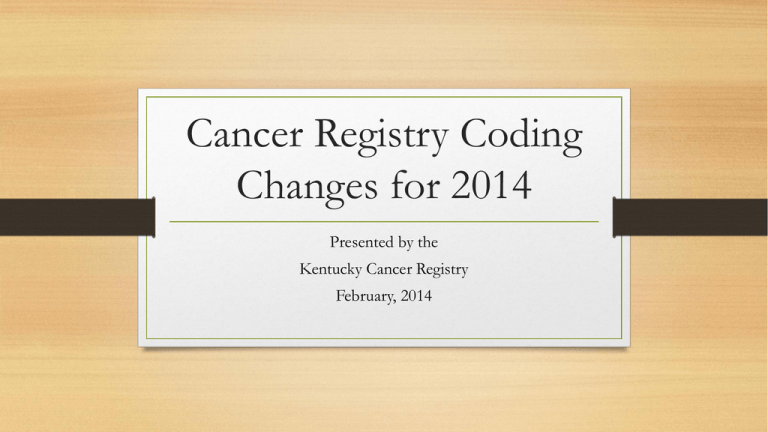
Cancer Registry Coding
Changes for 2014
Presented by the
Kentucky Cancer Registry
February, 2014
List of 2014 changes
•
•
•
•
•
•
Conversion from CSv02.04 to CSv02.05
Discontinue Grade Path Value/System; move to Historic tab
Tumor Grade coding instructions revised
Some ICD-O-3 updates implemented (preferred terms and synonyms)
Casefinding List based on ICD-10 codes added to CPDMS Manual
Hematopoietic Database and Manual revised for 2014
Presentation Agenda
• CSv02.05 changes
1 hour Frances
• Tumor Grade
15 mins.
Emily
• ICD-O-3 changes
15 mins
Emily
• Hematopoietic changes 30 mins.
Frances
Collaborative Stage v02.05
• Involves a data conversion of all cases back to 2004
• Must be used for initial data entry for all cases with a diagnosis date of Jan. 1, 2014 or later
• May be used for data entry of any cases with earlier diagnosis dates
• Some data items have been discontinued
• Grade Path System and Grade Path Value
• Some Site Specific Factors, which were never required
• Some coding instructions have been clarified
• Some corrections to the mapping algorithm for AJCC and Summary Stage values have been
implemented
New look for
CS web site
Click on
Software tab
Click on
Coding
Instructions
Coding Instructions tab
Contains links to
- a list of changes in v02.05 called Release Notes
- a list of requirements by each Standard Setter (CoC, SEER, NPCR)
- CS Coding Instructions - For this release, only the HTML Help format is
available for downloading:
A desktop icon that reads CS Manual Online Help, when double clicked, will open the
CS Coding Instructions software program. The program contains all schemas plus
general and site specific instructions. Extra tables which are not used for coding but
that may be helpful for data analyses are also included.
CS Data Conversion – some manual review and
re-coding will be required …
in these schemas:
…
•
•
•
•
Bile Ducts Intrahepatic and Bile Ducts Perihilar
Bladder
Head and Neck schemas
Nasopharynx
Bile Ducts Intrahepatic and Perihilar
• Review SSF 10 (Tumor Growth Pattern) if coded 000 or 999
Explanation
• Prior instructions for coding SSF10 for BileDuctsIntrahepat indicated that the
information should be coded based upon findings noted in the pathology report.
• Instructions have been modified to indicate that information can be obtained from radiology and
surgery reports as well as from pathology reports.
• Review all cases coded in the BileDuctsIntrahepat schema with an SSF 10 code of
000 or 999 to determine if a code of 010 should be assigned, which could change
the derived T and stage values.
• BileDuctsPerihilar should also be reviewed but it will not affect the derived T and stage values
Bladder
• Review cases with CS Lymph Nodes coded 400 or 450 and recode
SSF2 (Size of Metastasis in Lymph Nodes)
Explanation
• Prior instructions for coding SSF2 included coding the largest size of any
regional node listed under CS Lymph Nodes. SSF 2 instructions have been
modified to indicate common iliac nodes are excluded when determining size
of metastasis in lymph nodes.
• Recode SSF 2 based on the size of lymph node metastasis in iliac (internal,
external, NOS), obturator, pelvic, perivesical, sacral or regional nodes, NOS
only. Do not include common iliac nodes.
Head and Neck schemas
• Review SSF1 if coded 988
Explanation
• Any head and neck cases with code 988 in SSF1 should be reviewed and
recoded so that stage can be derived after conversion to v0205.
• KCR may not have any of these cases.
Nasopharynx
• Review cases with CS Lymph Nodes coded 130, 230, and 430
Explanation
• If any Level IV nodes were coded using these codes, then CS Lymph Nodes
needs to be recoded. All level IV nodes should be recoded to code 650.
Reviewable Cases and New Edits
When CPDMS.net is updated to CSv02.05, a list of the reviewable cases from
each hospital’s database will be placed on FES, along with instructions
regarding the type of review that is needed, based on the primary site.
Additional cases may fail edit checks now implemented with the 2014 changes.
You may encounter these as you edit old cases. You should run the report for
COC Edits to identify and fix these new errors.
Clarifications in the
General Instructions:
Highlights
Neoadjuvant Therapy
Neoadjuvant therapy affects coding of
• – Tumor Size and Extension
• Must be from the same time frame: clinical or y pathologic
• Remember, both data fields map to one T category
• – No response to therapy
• Infrequent that patient doesn’t respond to therapy
• Code CS Lymph Nodes from path report and eval 6
• – Lymph-vascular invasion (LVI) special instructions
• LVI present after neoadjuvant can be coded
• LVI not present after neoadjuvant cannot be coded
Eval 3 - Pathologic
• • Eval 3 – pathologic
– Resection path info + clinical eval info
– Resection path info + operative findings
• • Example
– Path report for resection has no tumor size
– Use physical exam or imaging tumor size
– Use eval 3 - pathologic
Physician Assignment T, N, M
When to use physician assigned T, N, M
– Doubt documentation in medical record is complete
– Physician T, N or M category differs from medical record
– Use “Stated as” code for physician T, N or M value
– Do not code to different value from medical record info
– Registrar documents rationale in abstract
Bone, Brain, Liver, & Lung Mets
Code 8 is for hematopoietic diseases (9590-9992)
For Unknown Primary
– Code 0, 1 or 9 for unknown primary sites
Exception added to code 8
- Code 8 when CS Mets at DX is coded as 98 (not applicable)
Lymph Node Eval – new examples
Eval 3 - pathologic
• – Diagnostic bx of lymph node
• – Subsequent primary resection
• – Rationale: part of workup, primary surgery meets criteria for pT, now meets pN
definition
Eval 3 – pathologic
• – Neck node dissection for treatment, no primary surgery
• – Rationale: part of treatment, meets pN definition
Pathologic Complete Response
• Pathologic complete response (pCR) to neoadjuvant therapy
– In situ disease only qualifies for complete response
– Residual Burden Calculator
• Score is 0 for in situ disease only
• Therefore, only in situ disease can have pCR
Breast SSFs on Multiple Tumors
Cases with in situ and invasive breast cancer, code the SSFs
– with the results of invasive ca, not in situ
– because treatment and outcomes based on the invasive tumor
Grade Collected in SSF
•
•
•
•
Code highest grade prior to neoadjuvant
– Neoadjuvant Rx could kill off highest grade tumor areas
– Behavior is based on highest grade prior to Rx
Breast, prostate, appendix carcinoid, soft tissue, sarcoma, kidney, renal pelvis,
ureter, bladder, urethra
Melanoma & Merkel Cell ITC’s
Melanoma and Merkel Cell carcinoma
– Isolated tumor cells (ITC’s)
– Considered positive nodes in these two sites
– Include in regional nodes positive count
– Include when coding positive nodes in CS Lymph Nodes data field
Discontinued Data Items
• Grade Path System and Grade Path Value have been discontinued by all
standard setters. These items will move to the ‘Historic’ tab in CPMS.net
• Many defined but never required Site Specific Factors have been
discontinued by all standard setters. They will continue to be displayed in
CPDMS.net with the 988 default value. SEER has discontinued some
formerly required SSFs, but CoC has not, so all required SSFs will be
continued until CS is discontinued in 2016.
New Coding Instructions Format
• As mentioned earlier , for this release, only the HTML Help format is
available.
• Download the Coding Instructions from the CS web site and install then on
your computer.
• A desktop icon that reads CS Manual Online Help will open the CS Coding
Instructions software program. The program contains all schemas plus
general and site specific instructions. Extra tables which are not used for
coding but that may be helpful for data analyses are also included.
CS Coding
Instructions


